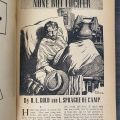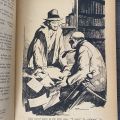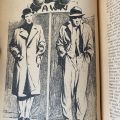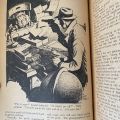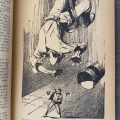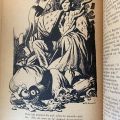During the Spring 2023 semester, Special Collections & Archives collaborated with Dr. Colleen Tripp's English 630, "Modern Monsters: Then & Now." Students in the class selected items from our collections of pulps, comics, and horror stories, then authored a series of blog posts in which they examined visual and other representations of the monstrous in the texts they chose. This is the sixth post of eight in the series.
None But Lucifer by H. L. Gold and L. Sprague de Camp is a Faustian satire set in New York City during the Great Depression. It was published in the pulp fantasy magazine Unknown in September 1939. The story of None But Lucifer focuses on William Hale, a businessman who discovers that Earth is Hell and Lucifer is ruling it. Hale devises a plan to confront Lucifer in order to make a deal for power and immortality. He does this by placing an ad in the paper which reads, “To none but Lucifer: Of all the inhabitants of the Inferno, none but Lucifer and I know that Hell is Hell”.1 This ad gets Lucifer’s attention because he does not want anyone to know that Earth is actually Hell, so they make a deal. Hale learns that in order to survive this deal, he’ll have to out-con Lucifer.
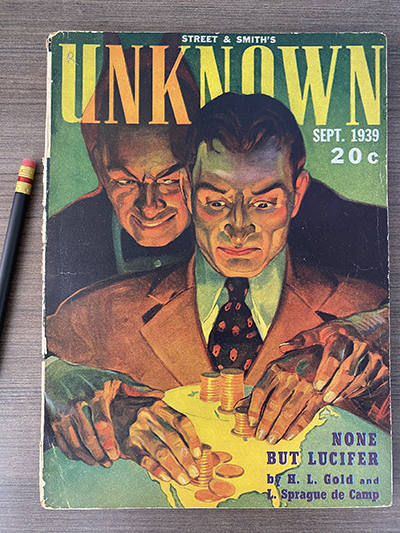 Unknown, later changed to Unknown Worlds, was an American pulp fantasy fiction magazine published by Street & Smith from 1939 to 1943. In The History of the Pulps, Brian Hoey states that while pulp magazines were often printed on cheap paper and considered low-brow, they usually contained the beginnings of the 20th century’s popular literary genre.2 Hoey also states that these texts were called pulps because the cheap paper used for them was made from wood pulp. The Special Collections & Archives’ copy of None But Lucifer, the seventh issue in Unknown’s run, is predictably very fragile. While the cover is extremely vibrant, the interior pages are yellowed with time and are tearing near the spine. Still, there are many detailed illustrations throughout that are worth a careful viewing.
Unknown, later changed to Unknown Worlds, was an American pulp fantasy fiction magazine published by Street & Smith from 1939 to 1943. In The History of the Pulps, Brian Hoey states that while pulp magazines were often printed on cheap paper and considered low-brow, they usually contained the beginnings of the 20th century’s popular literary genre.2 Hoey also states that these texts were called pulps because the cheap paper used for them was made from wood pulp. The Special Collections & Archives’ copy of None But Lucifer, the seventh issue in Unknown’s run, is predictably very fragile. While the cover is extremely vibrant, the interior pages are yellowed with time and are tearing near the spine. Still, there are many detailed illustrations throughout that are worth a careful viewing.
This issue was published the same month that World War II began. While Nazi Germany, led by Hitler, invaded Poland, None But Lucifer introduced another sinister ruler and the dark dealings of power in our world. The cover art of this issue was done by H. W. Scott, whom the New York Times describes as someone “best known for his dynamic human figures in western and sports pulps”.3 The cover depicts two businessmen, one leaning over the other from behind while holding the man’s hands. The image is shaded with a green tone and many shadows, evoking feelings of greed and a sinister mood fitting for the story. The man in the back, who is wearing a mischievous expression, is outlined by a red-tinged shadow of what appears to be a man’s head with horns, alluding to the man being the devil. These are the story’s leading characters, Johnson, otherwise known as Lucifer, and Hale. Their hands are resting on a globe, holding stacks of gold coins. This cover immediately reflects the plot that Hale, focused on money and perhaps power, is unknowingly controlled and tricked by Lucifer. The cover, with both men looming over the Earth but with Lucifer in control, adds to the idea that the Earth is actually Hell and Lucifer is the ruler.
This cover portrays homoerotic undertones, at least through a modern lens. The focal point of the cover is the hands of the two men. Lucifer is holding Hale’s hands very delicately. It is inherently intimate, showing no signs of force or pressure. The only sense of malevolency is from the expression on Lucifer’s face as if he is tricking Hale. This intimate physical contact between the two men, one being Lucifer, the most infamous sinner, suggests homoeroticism. It cannot be confirmed whether these homoerotic undertones were deliberate, but they definitely can reflect views of homosexuality at the time. In a dissertation titled American Homophobia: “The Homosexual Menace” in Twentieth-Century American Culture, author Paul Herman describes the ways in which homosexuals were viewed as deviants and menaces to American society. Herman states that “the homosexual-menace discourse came of age during the 1930s”,4 popularizing anxieties and negative depictions of homosexuality both in media and public discourse. This could arguably be seen in None But Lucifer’s cover art.
This cover also alludes to capitalism. The devil is an influential businessman who is in charge of both a large corporation and the world? That is very fitting. When living in a society or world run by capitalism, the power, much like on the cover of this magazine, is in the hands of those in charge. This theme of capitalism ties into the story itself, where the reader sees Hale fighting for both riches and power. Ultimately, not even making a deal with the devil can save Hale from capitalism because of the inherent power imbalance. Similarly, Unknown would not be spared by capitalism and was later canceled because of financial limitations due to wartime paper shortages.
1. Gold, H.L., and L. Sprague de Camp. None But Lucifer. Street & Smith's Unknown, 1939. 37.
2. Hoey, Brian. “The History of the Pulps.” Books Tell You Why, 23 July 2016, https://blog.bookstellyouwhy.com/the-history-of-the-pulps. Accessed 26 Apr. 2023.
3. Nevala-lee, Alec. “How Astounding Saw the Future.” The New York Times, The New York Times, 10 Jan. 2019, https://www.nytimes.com/2019/01/10/books/review/astounding-science-fiction-magazine.html.
4. Herman, Paul A. American Homophobia: “The Homosexual Menace” in Twentieth-Century American Culture, Stanford University, United States -- California, 2005: 75. ProQuest, https://libproxy.csun.edu/login?url=https://www.proquest.com/dissertations-theses/american-homophobia-homosexual-menace-twentieth/docview/305434202/se-2.



